-2024届高三英语二轮复习特殊句式课件(共34张PPT)
文档属性
| 名称 | -2024届高三英语二轮复习特殊句式课件(共34张PPT) | 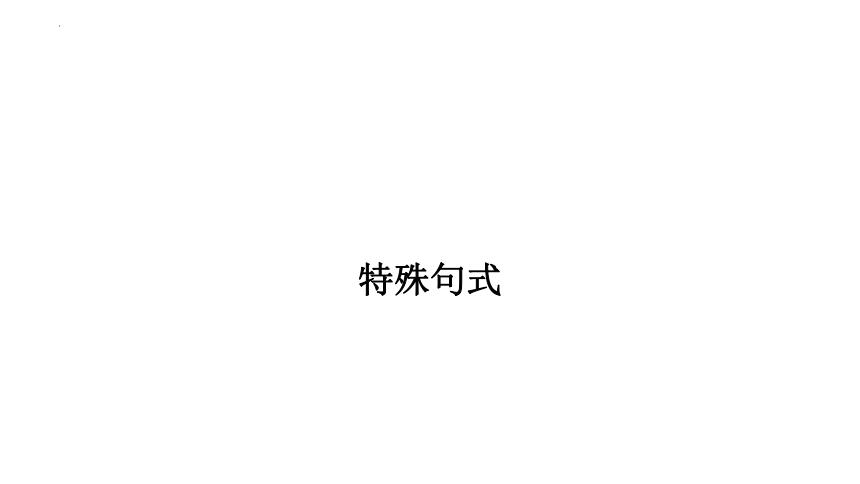 | |
| 格式 | pptx | ||
| 文件大小 | 126.7KB | ||
| 资源类型 | 教案 | ||
| 版本资源 | 通用版 | ||
| 科目 | 英语 | ||
| 更新时间 | 2023-10-23 19:01:37 | ||
图片预览

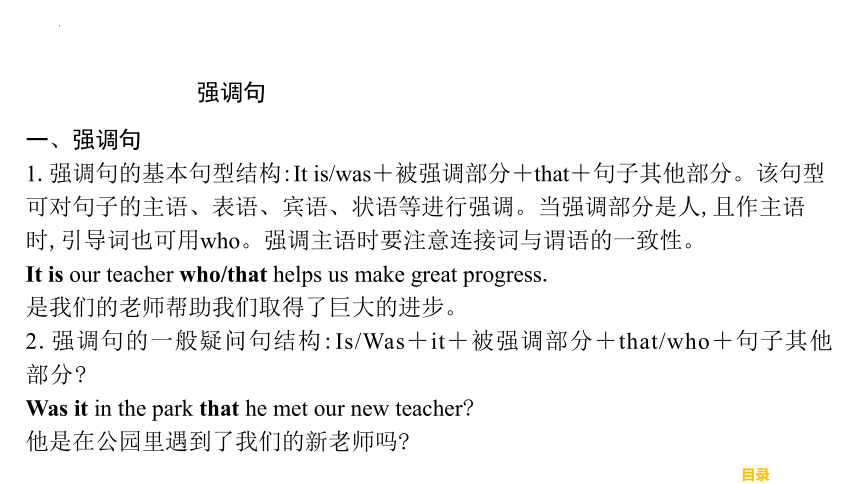
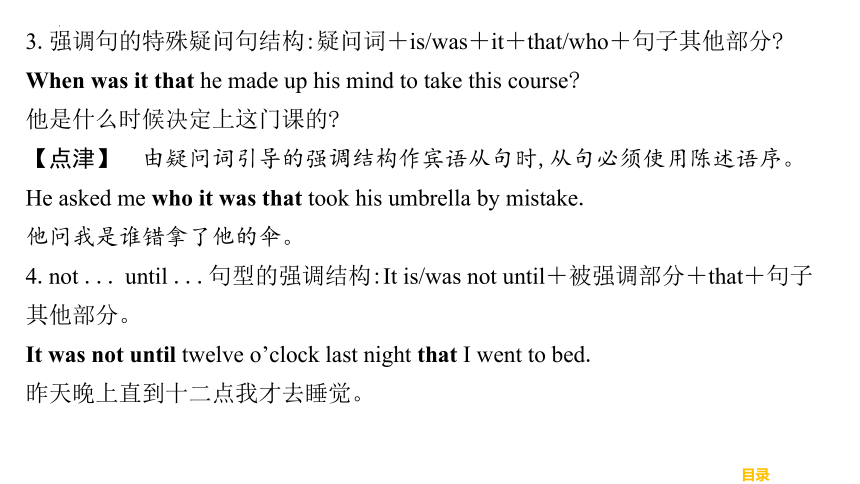
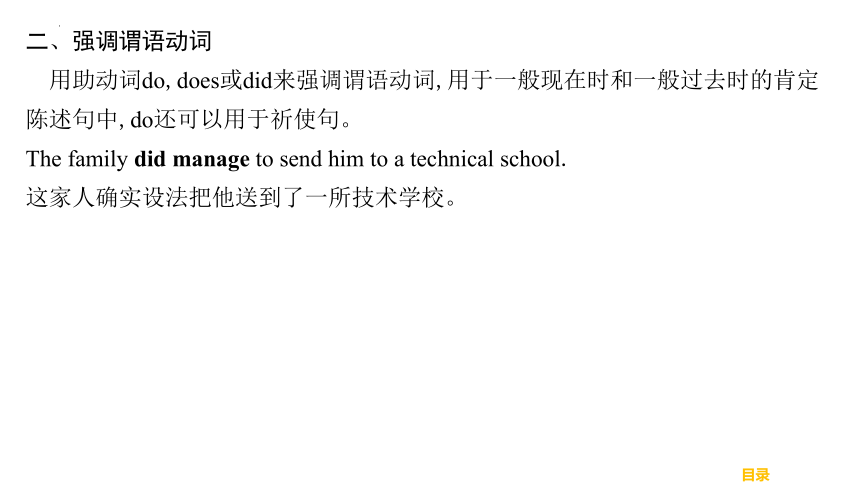
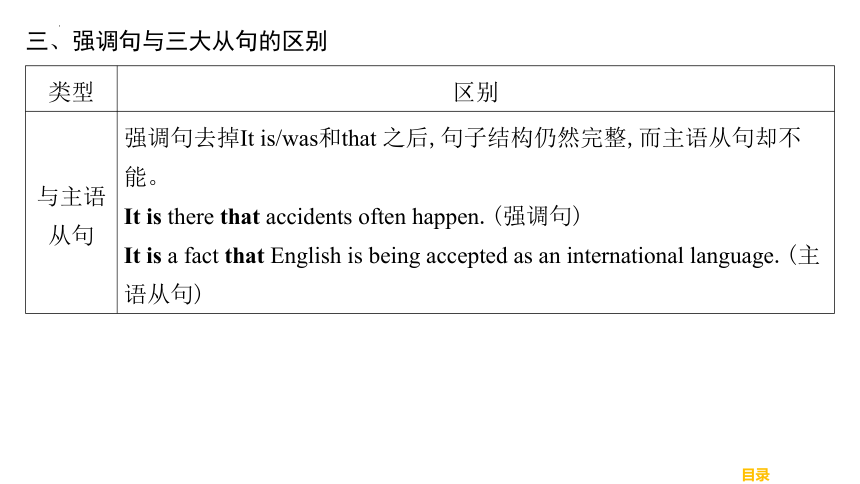
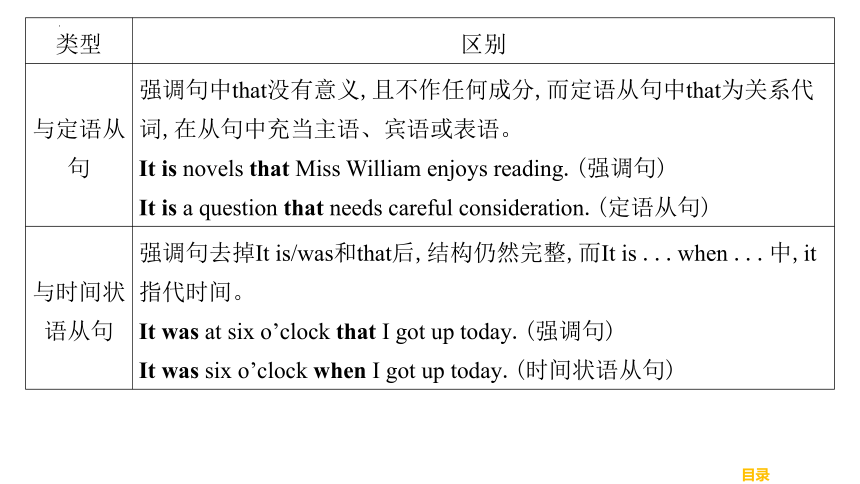
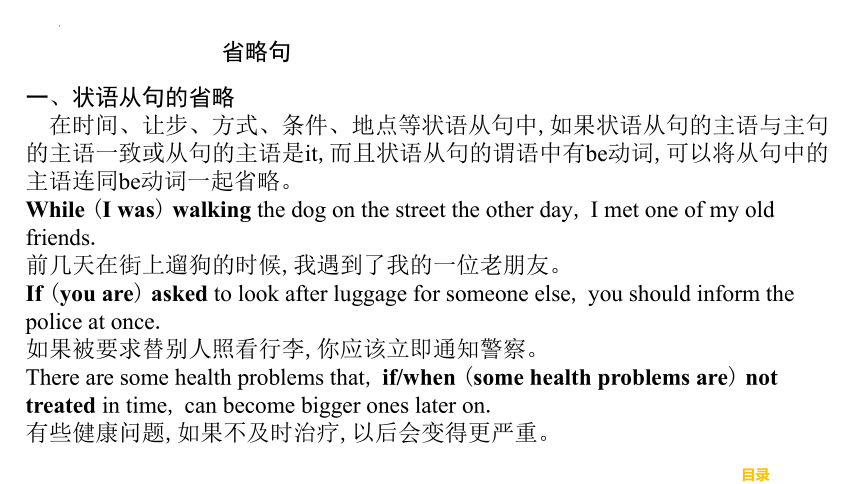

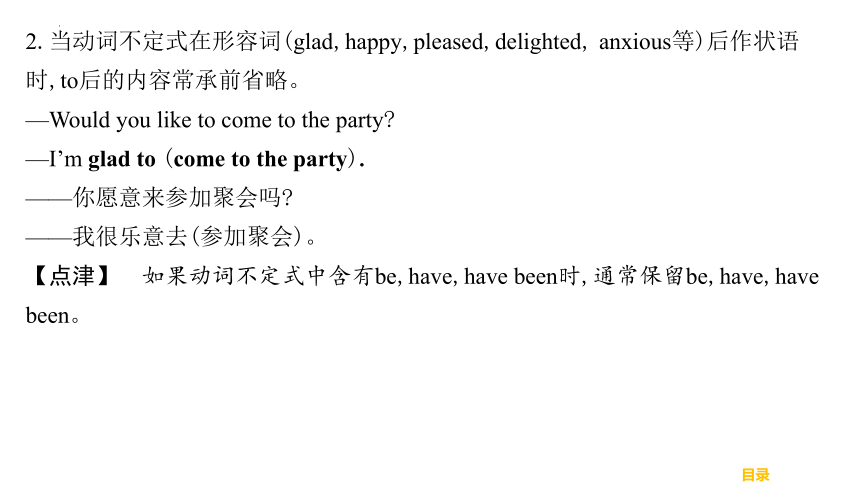
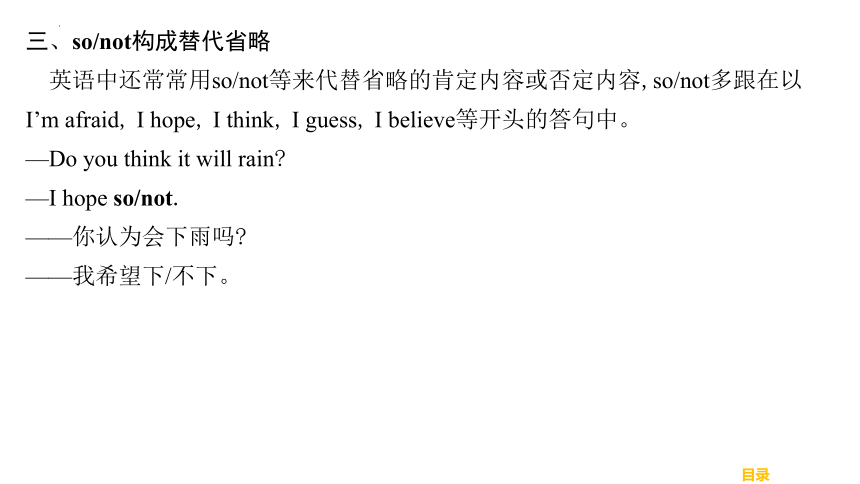
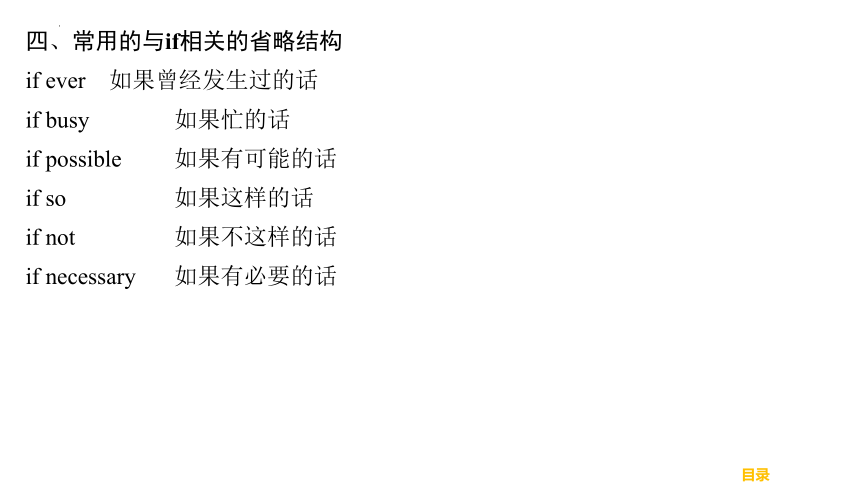
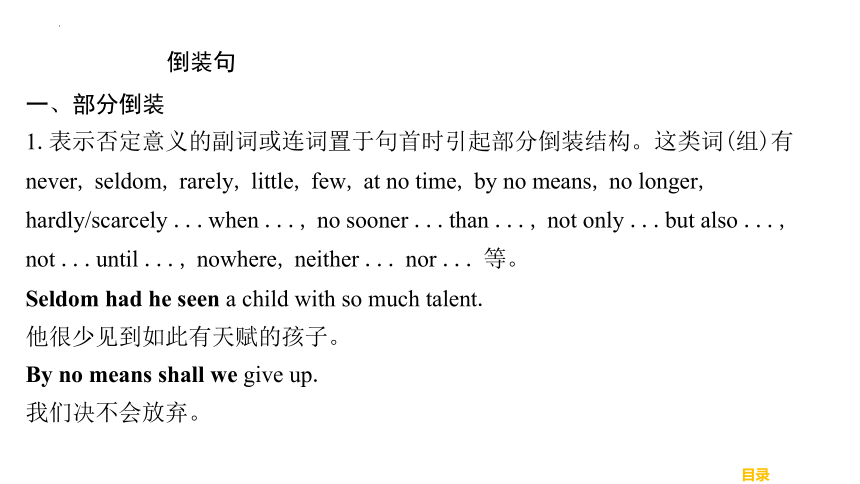
文档简介
(共34张PPT)
特殊句式
强调句
一、强调句
1.强调句的基本句型结构:It is/was+被强调部分+that+句子其他部分。该句型可对句子的主语、表语、宾语、状语等进行强调。当强调部分是人,且作主语时,引导词也可用who。强调主语时要注意连接词与谓语的一致性。
It is our teacher who/that helps us make great progress.
是我们的老师帮助我们取得了巨大的进步。
2.强调句的一般疑问句结构:Is/Was+it+被强调部分+that/who+句子其他部分
Was it in the park that he met our new teacher
他是在公园里遇到了我们的新老师吗
3.强调句的特殊疑问句结构:疑问词+is/was+it+that/who+句子其他部分
When was it that he made up his mind to take this course
他是什么时候决定上这门课的
【点津】 由疑问词引导的强调结构作宾语从句时,从句必须使用陈述语序。
He asked me who it was that took his umbrella by mistake.
他问我是谁错拿了他的伞。
4.not ... until ...句型的强调结构:It is/was not until+被强调部分+that+句子其他部分。
It was not until twelve o’clock last night that I went to bed.
昨天晚上直到十二点我才去睡觉。
二、强调谓语动词
用助动词do,does或did来强调谓语动词,用于一般现在时和一般过去时的肯定陈述句中,do还可以用于祈使句。
The family did manage to send him to a technical school.
这家人确实设法把他送到了一所技术学校。
三、强调句与三大从句的区别
类型 区别
与主语从句 强调句去掉It is/was和that 之后,句子结构仍然完整,而主语从句却不能。
It is there that accidents often happen.(强调句)
It is a fact that English is being accepted as an international language.(主语从句)
类型 区别
与定语从句 强调句中that没有意义,且不作任何成分,而定语从句中that为关系代词,在从句中充当主语、宾语或表语。
It is novels that Miss William enjoys reading.(强调句)
It is a question that needs careful consideration.(定语从句)
与时间状语从句 强调句去掉It is/was和that后,结构仍然完整,而It is ...when ...中,it指代时间。
It was at six o’clock that I got up today.(强调句)
It was six o’clock when I got up today.(时间状语从句)
省略句
一、状语从句的省略
在时间、让步、方式、条件、地点等状语从句中,如果状语从句的主语与主句的主语一致或从句的主语是it,而且状语从句的谓语中有be动词,可以将从句中的主语连同be动词一起省略。
While (I was) walking the dog on the street the other day, I met one of my old friends.
前几天在街上遛狗的时候,我遇到了我的一位老朋友。
If (you are) asked to look after luggage for someone else, you should inform the police at once.
如果被要求替别人照看行李,你应该立即通知警察。
There are some health problems that, if/when (some health problems are) not treated in time, can become bigger ones later on.
有些健康问题,如果不及时治疗,以后会变得更严重。
二、动词不定式的省略
1.动词不定式作动词(expect, refuse, mean, like, love, prefer, wish, hope, want 等)的宾语时,常承前省略动词不定式后的内容,但保留动词不定式符号to。
John didn’t pass his driving test, but I expected him to (pass his driving test).
约翰没有通过驾照考试,不过我希望他能通过。
2.当动词不定式在形容词(glad,happy,pleased,delighted, anxious等)后作状语时,to后的内容常承前省略。
—Would you like to come to the party
—I’m glad to (come to the party).
——你愿意来参加聚会吗
——我很乐意去(参加聚会)。
【点津】 如果动词不定式中含有be,have,have been时,通常保留be,have,have been。
三、so/not构成替代省略
英语中还常常用so/not等来代替省略的肯定内容或否定内容,so/not多跟在以I’m afraid, I hope, I think, I guess, I believe等开头的答句中。
—Do you think it will rain
—I hope so/not.
——你认为会下雨吗
——我希望下/不下。
四、常用的与if相关的省略结构
if ever 如果曾经发生过的话
if busy 如果忙的话
if possible 如果有可能的话
if so 如果这样的话
if not 如果不这样的话
if necessary 如果有必要的话
一、部分倒装
1.表示否定意义的副词或连词置于句首时引起部分倒装结构。这类词(组)有never, seldom, rarely, little, few, at no time, by no means, no longer, hardly/scarcely ...when ..., no sooner ...than ..., not only ...but also ..., not ...until ..., nowhere, neither ... nor ... 等。
Seldom had he seen a child with so much talent.
他很少见到如此有天赋的孩子。
By no means shall we give up.
我们决不会放弃。
倒装句
2.“only+状语(从句)”置于句首时,句子(主句)要用部分倒装。
Only when he returned did we find out the truth.
只有当他回来之后,我们才发现事实的真相。
3.so/such ... that ... 结构中的so,such连同它所修饰的成分共同位于句首表示强调时,主句要用部分倒装。
So beautiful was the girl that she won the championship in the beauty contest.
这位小女孩非常漂亮,所以她赢得了选美比赛的冠军。
4.表示前面所说的情况也适用于后者时,用倒装结构“so/neither/nor+助动词/系动词/情态动词+主语”(so 表示肯定意义,neither/nor 表示否定意义)。
This is not my story; nor is it the whole story.My story plays out differently.
这不是我的故事;也不是故事的全部。我的故事结局不同。
5.在as/though引导的让步状语从句中,从句的表语/状语/动词原形要位于句首,构成倒装结构。如果位于句首的是单数可数名词,其前不加冠词。
Strange as it may sound, if you’re unsatisfied, the issue is not a lack of means to meet your desires but a lack of desires.
尽管这听起来很奇怪,但是如果你不满意,问题不是缺少满足你愿望的方法,而是你根本就没有愿望。
二、完全倒装
1.here, there, now, then, out, in, up, down, away, on the wall, in the room 等表示地点、时间或方位的副词或介词短语置于句首,且句子主语是名词时,句子用完全倒装。如果主语是人称代词,则不用倒装语序。
By the window sat a young man with a magazine in his hand.
一位年轻人坐在窗边,手里拿着一本杂志。
2.有时为平衡句子结构或突出强调,将作表语的介词短语、形容词、副词或分词提到句首,构成“表语+系动词+主语”的完全倒装结构。
Present at the party were Mr Green and many other guests.
出席晚会的有格林先生,还有许多其他宾客。
一、感叹句
1.what引导的感叹句
(1)What+a/an+形容词+可数名词单数+主语+谓语!
What a beautiful picture it is!
多么美丽的一幅画啊!
(2)What+形容词+不可数名词/可数名词复数+主语+谓语!
What interesting stories he’s told us!
他给我们讲的故事真有趣!
其他特殊句式
2.how引导的感叹句
(1)How+形容词+a/an+可数名词单数+主语+谓语!
How clever a boy he is!=What a clever boy he is!
他是一个多么聪明的男孩呀!
(2)How+形容词/副词+主语+谓语!
How high the mountain is!
这山真高呀!
二、祈使句
祈使句表示请求、命令、叮嘱、邀请、劝告等。句中一般不出现主语,谓语动词一律用原形;否定形式一律在动词前加don’t;强调形式是在句首加do。
Do be careful while you are crossing the road.
过马路时你一定要小心。
三、附加疑问句
附加疑问句,又称反意疑问句,由“陈述部分+附加疑问部分”构成,若陈述部分为肯定式,则附加疑问部分为否定式,反之亦然。
1.陈述部分含有must的附加疑问句
(1)当must作“必须”讲时,其附加疑问句的动词用needn’t; 当mustn’t作“不允许,禁止”讲时,其附加疑问句的动词用must。
You must go now, needn’t you
你现在必须走,不是吗
You mustn’t smoke here, must you
你不能在这里吸烟,是吧
(2)当must表示推测,作“一定,准是”讲时,附加疑问部分的动词形式要根据must后面的动词所表示的时间来确定。
You must have watched the football match last night, didn’t you
你昨晚一定看足球比赛了,不是吗
2.陈述部分含有used to时,其附加疑问句的动词用usedn’t或didn’t均可。
You used to play football, usedn’t/didn’t you
你过去常常踢足球,不是吗
3.陈述部分含有ought to时,其附加疑问句的动词用oughtn’t或shouldn’t均可。
He ought to attend the meeting, oughtn’t/shouldn’t he
他应该参加会议,不是吗
4.陈述部分含有否定词的附加疑问句
(1)当陈述部分含有seldom, hardly, scarcely, never, few, little, nothing, nobody等否定词或半否定词时,附加疑问部分动词用肯定式。
He could hardly get up, could he
他几乎起不来了,是吗
(2)陈述部分含有由表示否定意义的前缀或后缀构成的词,附加疑问部分的动词一般用否定式。
Mary dislikes sports, doesn’t she
玛丽不喜欢体育运动,不是吗
(3)陈述部分含有宾语从句时,附加疑问部分的主语和动词应和主句的主语和谓语保持一致。
He said that she would come here on time, didn’t he
他说她会准时来这里,不是吗
【点津】 当主句是I think/believe/suppose等结构时,附加疑问部分往往根据宾语从句的主语和谓语而定,需特别注意否定转移现象中的肯定式和否定式。
I don’t think he will attend the meeting on time, will he
我认为他不会准时参加会议,是吗
Ⅰ.单句语法填空
1.When (ride) a bicycle, you don’t use petrol.
解析:riding 考查状语从句的省略。主从句的主语一致,从句中省略了主语和be动词,补充完整为When you are riding a bicycle。
2.Why is it some people are so much more intelligent or creative than the rest of us
解析:that 该句是强调句的特殊疑问句式,故填that。
3.Unlike a normal Parisian apartment, the plumbing (水管) worked. There (be) a nice kitchen and a comfortable bed.
解析:was 该句是there be句型, be动词的数与后面的a nice kitchen的数一致,应用单数,上一句是一般过去时,该句应用一般过去时,故填was。
4.It was only when the car pulled up in front of our house we saw Lily in the passenger seat.
解析:that 此处是强调句:It was+被强调部分+that+句子其他部分。本句强调的是时间状语。故填that。
5.In any unsafe situation, simply (press) the button and a highly-trained agent will get you the help you need.
解析:press 此句为“祈使句+and+陈述句”结构,应用动词原形。故填press。
6.Between rows of trees (stand) a new building, which is supposed to be our new library.
解析:stands 表示地点的介词短语位于句首,且句子主语为名词时,句子用完全倒装语序。本句为一般性的描述,应用一般现在时,主语a new building为第三人称单数,谓语动词应用第三人称单数形式,故填stands。
7. (be) it not for the support of the teachers, the student could not overcome her difficulty.
解析:Were 该句是省略了if的虚拟条件句,条件句中be动词应用were, if省略后需要将were提前,构成部分倒装,需注意首字母大写。故填Were。
8.If (accept) for the job, you’ll be informed soon.
解析:accepted 考查省略句。句中you与accept之间为被动关系,应用过去分词。从句中if后省略了主语和be动词,补充完整为:If you are accepted for the job。
9.Video games can be a poor influence if (leave) in the wrong hands.
解析:left 考查省略句。leave的逻辑主语是video games,主语video games与leave之间是被动关系,应用过去分词。if left ...是“连词+过去分词”构成的状语从句的省略。
10.Always (keep) in mind that your main task is to get this company running smoothly.
解析:keep 考查祈使句。祈使句一般以动词原形开头,故填keep。
Ⅱ.语法填空
Shen Kuo was a scientist of the Northern Song Dynasty. He was 1 all-round scholar of astronomy, physics, chemistry, geology and medical science. 2 , Shen Kuo’s reputation has been mostly in the field of scientific writing: He was the first 3 (build) graphic maps.
Thanks 4 his mother, Shen Kuo received a formal education in his childhood. He was diligent and he read so much that he suffered eye pain later in life. While in his 5 (thirty), Shen Kuo frequently dreamed of a place. In the dream, he climbed a hill, the top of 6 was covered with brightly colored flowers and trees. Clear waters 7 (flow) at the base of the hill, with trees on either side. Later on, when 8 (travel) around, he was shocked to find a piece of land that was 9 (exact) the one in his dream. There he settled and wrote of the discoveries he had made during his lifetime.
This extraordinary story is the origin of Shen’s Dream Pool Essays (《梦溪笔谈》).The Dream Pool Essays was a milestone in the history of Chinese science. So far, this amazing scientific work 10 (translate) into a number of different languages, including English, French, German and Japanese.
语篇解读:本文是一篇说明文。文章主要介绍了北宋时期著名的科学家沈括及其创作的《梦溪笔谈》。
1.an 考查冠词。scholar是可数名词单数,且在语境中第一次出现,表示泛指,应用不定冠词修饰,又因all的发音以元音音素开头,故填an。
2.However 考查副词。分析句子结构可知,设空处应为副词作状语,且上下文之间为逻辑上的转折关系,故填However。
3.to build 考查非谓语动词。分析句子结构可知,本句的谓语动词是was,所以设空处应用非谓语动词形式。序数词后往往跟动词不定式作后置定语,故填to build。
4.to 考查介词。thanks to为固定搭配,意为“幸亏,由于”,故填to。
5.thirties 考查名词的单复数。in one’s thirties为固定用法,意为“在某人三十多岁时”,故填thirties。
6.which 考查定语从句。分析句子结构可知,设空处引导非限制性定语从句,在从句中作主语,修饰先行词a hill,故填which。
7.flowed 考查动词的时态。分析句子结构可知,设空处在句中作谓语,与上句中的谓语climbed的时态应保持一致,应用一般过去时,故填flowed。
8.travel(l)ing 考查省略结构。本句是一个省略句,即当从句的主语和be动词与主句的主语和be动词一致时,从句主语和be动词一般可以省略,本句可还原为:when he was travel(l)ing,故填travel(l)ing。
9.exactly 考查词形转换。分析句子结构可知,设空处应用副词作状语,修饰动词was,故填exactly。
10.has been translated 考查动词的时态、语态和主谓一致。分析句子结构可知,设空处在句中作谓语,由时间状语So far可知,应用现在完成时;translate和句子主语this amazing scientific work之间为被动关系;且主语为第三人称单数。故填has been translated。
Ⅲ.写作运用(根据汉语提示完成下面短文,注意特殊句式的运用)
My favourite proverb is “Where there’s a will, there’s a way.” It means that only if we stick to our dreams and never give up 1.will we be able to overcome all kinds of difficulties (我们才能克服各种各样的困难).
will we be able to overcome all
kinds of difficulties
Memories rushed to my mind when I saw this topic.2.When in high school (在高中的时候), I had great enthusiasm for English and intended to take part in an English speech contest.However, 3.when preparing for it (在准备比赛的时候), I found it very challenging to collect information and use the language correctly.I was about to give up when my dad noticed and offered this proverb to me.Thanks to my father’s encouragement, I spared no effort to solve every problem with confidence.If it hadn’t helped me, I couldn’t have won the prize finally.Only then 4.did I realize how important a strong will is (我才意识到坚强的意志是多么重要)!
When in high school
when preparing for it
did I realize
how important a strong will is
In a word, 5.not only does the proverb enable me to face the difficulties bravely (这句谚语不仅使我勇敢地面对困难), but it also contributes much to keeping confident all the time. Therefore, keep in mind — Where there’s a will, there’s a way.Success comes to those who never give up.
not only does the proverb enable me to face the difficulties bravely
特殊句式
强调句
一、强调句
1.强调句的基本句型结构:It is/was+被强调部分+that+句子其他部分。该句型可对句子的主语、表语、宾语、状语等进行强调。当强调部分是人,且作主语时,引导词也可用who。强调主语时要注意连接词与谓语的一致性。
It is our teacher who/that helps us make great progress.
是我们的老师帮助我们取得了巨大的进步。
2.强调句的一般疑问句结构:Is/Was+it+被强调部分+that/who+句子其他部分
Was it in the park that he met our new teacher
他是在公园里遇到了我们的新老师吗
3.强调句的特殊疑问句结构:疑问词+is/was+it+that/who+句子其他部分
When was it that he made up his mind to take this course
他是什么时候决定上这门课的
【点津】 由疑问词引导的强调结构作宾语从句时,从句必须使用陈述语序。
He asked me who it was that took his umbrella by mistake.
他问我是谁错拿了他的伞。
4.not ... until ...句型的强调结构:It is/was not until+被强调部分+that+句子其他部分。
It was not until twelve o’clock last night that I went to bed.
昨天晚上直到十二点我才去睡觉。
二、强调谓语动词
用助动词do,does或did来强调谓语动词,用于一般现在时和一般过去时的肯定陈述句中,do还可以用于祈使句。
The family did manage to send him to a technical school.
这家人确实设法把他送到了一所技术学校。
三、强调句与三大从句的区别
类型 区别
与主语从句 强调句去掉It is/was和that 之后,句子结构仍然完整,而主语从句却不能。
It is there that accidents often happen.(强调句)
It is a fact that English is being accepted as an international language.(主语从句)
类型 区别
与定语从句 强调句中that没有意义,且不作任何成分,而定语从句中that为关系代词,在从句中充当主语、宾语或表语。
It is novels that Miss William enjoys reading.(强调句)
It is a question that needs careful consideration.(定语从句)
与时间状语从句 强调句去掉It is/was和that后,结构仍然完整,而It is ...when ...中,it指代时间。
It was at six o’clock that I got up today.(强调句)
It was six o’clock when I got up today.(时间状语从句)
省略句
一、状语从句的省略
在时间、让步、方式、条件、地点等状语从句中,如果状语从句的主语与主句的主语一致或从句的主语是it,而且状语从句的谓语中有be动词,可以将从句中的主语连同be动词一起省略。
While (I was) walking the dog on the street the other day, I met one of my old friends.
前几天在街上遛狗的时候,我遇到了我的一位老朋友。
If (you are) asked to look after luggage for someone else, you should inform the police at once.
如果被要求替别人照看行李,你应该立即通知警察。
There are some health problems that, if/when (some health problems are) not treated in time, can become bigger ones later on.
有些健康问题,如果不及时治疗,以后会变得更严重。
二、动词不定式的省略
1.动词不定式作动词(expect, refuse, mean, like, love, prefer, wish, hope, want 等)的宾语时,常承前省略动词不定式后的内容,但保留动词不定式符号to。
John didn’t pass his driving test, but I expected him to (pass his driving test).
约翰没有通过驾照考试,不过我希望他能通过。
2.当动词不定式在形容词(glad,happy,pleased,delighted, anxious等)后作状语时,to后的内容常承前省略。
—Would you like to come to the party
—I’m glad to (come to the party).
——你愿意来参加聚会吗
——我很乐意去(参加聚会)。
【点津】 如果动词不定式中含有be,have,have been时,通常保留be,have,have been。
三、so/not构成替代省略
英语中还常常用so/not等来代替省略的肯定内容或否定内容,so/not多跟在以I’m afraid, I hope, I think, I guess, I believe等开头的答句中。
—Do you think it will rain
—I hope so/not.
——你认为会下雨吗
——我希望下/不下。
四、常用的与if相关的省略结构
if ever 如果曾经发生过的话
if busy 如果忙的话
if possible 如果有可能的话
if so 如果这样的话
if not 如果不这样的话
if necessary 如果有必要的话
一、部分倒装
1.表示否定意义的副词或连词置于句首时引起部分倒装结构。这类词(组)有never, seldom, rarely, little, few, at no time, by no means, no longer, hardly/scarcely ...when ..., no sooner ...than ..., not only ...but also ..., not ...until ..., nowhere, neither ... nor ... 等。
Seldom had he seen a child with so much talent.
他很少见到如此有天赋的孩子。
By no means shall we give up.
我们决不会放弃。
倒装句
2.“only+状语(从句)”置于句首时,句子(主句)要用部分倒装。
Only when he returned did we find out the truth.
只有当他回来之后,我们才发现事实的真相。
3.so/such ... that ... 结构中的so,such连同它所修饰的成分共同位于句首表示强调时,主句要用部分倒装。
So beautiful was the girl that she won the championship in the beauty contest.
这位小女孩非常漂亮,所以她赢得了选美比赛的冠军。
4.表示前面所说的情况也适用于后者时,用倒装结构“so/neither/nor+助动词/系动词/情态动词+主语”(so 表示肯定意义,neither/nor 表示否定意义)。
This is not my story; nor is it the whole story.My story plays out differently.
这不是我的故事;也不是故事的全部。我的故事结局不同。
5.在as/though引导的让步状语从句中,从句的表语/状语/动词原形要位于句首,构成倒装结构。如果位于句首的是单数可数名词,其前不加冠词。
Strange as it may sound, if you’re unsatisfied, the issue is not a lack of means to meet your desires but a lack of desires.
尽管这听起来很奇怪,但是如果你不满意,问题不是缺少满足你愿望的方法,而是你根本就没有愿望。
二、完全倒装
1.here, there, now, then, out, in, up, down, away, on the wall, in the room 等表示地点、时间或方位的副词或介词短语置于句首,且句子主语是名词时,句子用完全倒装。如果主语是人称代词,则不用倒装语序。
By the window sat a young man with a magazine in his hand.
一位年轻人坐在窗边,手里拿着一本杂志。
2.有时为平衡句子结构或突出强调,将作表语的介词短语、形容词、副词或分词提到句首,构成“表语+系动词+主语”的完全倒装结构。
Present at the party were Mr Green and many other guests.
出席晚会的有格林先生,还有许多其他宾客。
一、感叹句
1.what引导的感叹句
(1)What+a/an+形容词+可数名词单数+主语+谓语!
What a beautiful picture it is!
多么美丽的一幅画啊!
(2)What+形容词+不可数名词/可数名词复数+主语+谓语!
What interesting stories he’s told us!
他给我们讲的故事真有趣!
其他特殊句式
2.how引导的感叹句
(1)How+形容词+a/an+可数名词单数+主语+谓语!
How clever a boy he is!=What a clever boy he is!
他是一个多么聪明的男孩呀!
(2)How+形容词/副词+主语+谓语!
How high the mountain is!
这山真高呀!
二、祈使句
祈使句表示请求、命令、叮嘱、邀请、劝告等。句中一般不出现主语,谓语动词一律用原形;否定形式一律在动词前加don’t;强调形式是在句首加do。
Do be careful while you are crossing the road.
过马路时你一定要小心。
三、附加疑问句
附加疑问句,又称反意疑问句,由“陈述部分+附加疑问部分”构成,若陈述部分为肯定式,则附加疑问部分为否定式,反之亦然。
1.陈述部分含有must的附加疑问句
(1)当must作“必须”讲时,其附加疑问句的动词用needn’t; 当mustn’t作“不允许,禁止”讲时,其附加疑问句的动词用must。
You must go now, needn’t you
你现在必须走,不是吗
You mustn’t smoke here, must you
你不能在这里吸烟,是吧
(2)当must表示推测,作“一定,准是”讲时,附加疑问部分的动词形式要根据must后面的动词所表示的时间来确定。
You must have watched the football match last night, didn’t you
你昨晚一定看足球比赛了,不是吗
2.陈述部分含有used to时,其附加疑问句的动词用usedn’t或didn’t均可。
You used to play football, usedn’t/didn’t you
你过去常常踢足球,不是吗
3.陈述部分含有ought to时,其附加疑问句的动词用oughtn’t或shouldn’t均可。
He ought to attend the meeting, oughtn’t/shouldn’t he
他应该参加会议,不是吗
4.陈述部分含有否定词的附加疑问句
(1)当陈述部分含有seldom, hardly, scarcely, never, few, little, nothing, nobody等否定词或半否定词时,附加疑问部分动词用肯定式。
He could hardly get up, could he
他几乎起不来了,是吗
(2)陈述部分含有由表示否定意义的前缀或后缀构成的词,附加疑问部分的动词一般用否定式。
Mary dislikes sports, doesn’t she
玛丽不喜欢体育运动,不是吗
(3)陈述部分含有宾语从句时,附加疑问部分的主语和动词应和主句的主语和谓语保持一致。
He said that she would come here on time, didn’t he
他说她会准时来这里,不是吗
【点津】 当主句是I think/believe/suppose等结构时,附加疑问部分往往根据宾语从句的主语和谓语而定,需特别注意否定转移现象中的肯定式和否定式。
I don’t think he will attend the meeting on time, will he
我认为他不会准时参加会议,是吗
Ⅰ.单句语法填空
1.When (ride) a bicycle, you don’t use petrol.
解析:riding 考查状语从句的省略。主从句的主语一致,从句中省略了主语和be动词,补充完整为When you are riding a bicycle。
2.Why is it some people are so much more intelligent or creative than the rest of us
解析:that 该句是强调句的特殊疑问句式,故填that。
3.Unlike a normal Parisian apartment, the plumbing (水管) worked. There (be) a nice kitchen and a comfortable bed.
解析:was 该句是there be句型, be动词的数与后面的a nice kitchen的数一致,应用单数,上一句是一般过去时,该句应用一般过去时,故填was。
4.It was only when the car pulled up in front of our house we saw Lily in the passenger seat.
解析:that 此处是强调句:It was+被强调部分+that+句子其他部分。本句强调的是时间状语。故填that。
5.In any unsafe situation, simply (press) the button and a highly-trained agent will get you the help you need.
解析:press 此句为“祈使句+and+陈述句”结构,应用动词原形。故填press。
6.Between rows of trees (stand) a new building, which is supposed to be our new library.
解析:stands 表示地点的介词短语位于句首,且句子主语为名词时,句子用完全倒装语序。本句为一般性的描述,应用一般现在时,主语a new building为第三人称单数,谓语动词应用第三人称单数形式,故填stands。
7. (be) it not for the support of the teachers, the student could not overcome her difficulty.
解析:Were 该句是省略了if的虚拟条件句,条件句中be动词应用were, if省略后需要将were提前,构成部分倒装,需注意首字母大写。故填Were。
8.If (accept) for the job, you’ll be informed soon.
解析:accepted 考查省略句。句中you与accept之间为被动关系,应用过去分词。从句中if后省略了主语和be动词,补充完整为:If you are accepted for the job。
9.Video games can be a poor influence if (leave) in the wrong hands.
解析:left 考查省略句。leave的逻辑主语是video games,主语video games与leave之间是被动关系,应用过去分词。if left ...是“连词+过去分词”构成的状语从句的省略。
10.Always (keep) in mind that your main task is to get this company running smoothly.
解析:keep 考查祈使句。祈使句一般以动词原形开头,故填keep。
Ⅱ.语法填空
Shen Kuo was a scientist of the Northern Song Dynasty. He was 1 all-round scholar of astronomy, physics, chemistry, geology and medical science. 2 , Shen Kuo’s reputation has been mostly in the field of scientific writing: He was the first 3 (build) graphic maps.
Thanks 4 his mother, Shen Kuo received a formal education in his childhood. He was diligent and he read so much that he suffered eye pain later in life. While in his 5 (thirty), Shen Kuo frequently dreamed of a place. In the dream, he climbed a hill, the top of 6 was covered with brightly colored flowers and trees. Clear waters 7 (flow) at the base of the hill, with trees on either side. Later on, when 8 (travel) around, he was shocked to find a piece of land that was 9 (exact) the one in his dream. There he settled and wrote of the discoveries he had made during his lifetime.
This extraordinary story is the origin of Shen’s Dream Pool Essays (《梦溪笔谈》).The Dream Pool Essays was a milestone in the history of Chinese science. So far, this amazing scientific work 10 (translate) into a number of different languages, including English, French, German and Japanese.
语篇解读:本文是一篇说明文。文章主要介绍了北宋时期著名的科学家沈括及其创作的《梦溪笔谈》。
1.an 考查冠词。scholar是可数名词单数,且在语境中第一次出现,表示泛指,应用不定冠词修饰,又因all的发音以元音音素开头,故填an。
2.However 考查副词。分析句子结构可知,设空处应为副词作状语,且上下文之间为逻辑上的转折关系,故填However。
3.to build 考查非谓语动词。分析句子结构可知,本句的谓语动词是was,所以设空处应用非谓语动词形式。序数词后往往跟动词不定式作后置定语,故填to build。
4.to 考查介词。thanks to为固定搭配,意为“幸亏,由于”,故填to。
5.thirties 考查名词的单复数。in one’s thirties为固定用法,意为“在某人三十多岁时”,故填thirties。
6.which 考查定语从句。分析句子结构可知,设空处引导非限制性定语从句,在从句中作主语,修饰先行词a hill,故填which。
7.flowed 考查动词的时态。分析句子结构可知,设空处在句中作谓语,与上句中的谓语climbed的时态应保持一致,应用一般过去时,故填flowed。
8.travel(l)ing 考查省略结构。本句是一个省略句,即当从句的主语和be动词与主句的主语和be动词一致时,从句主语和be动词一般可以省略,本句可还原为:when he was travel(l)ing,故填travel(l)ing。
9.exactly 考查词形转换。分析句子结构可知,设空处应用副词作状语,修饰动词was,故填exactly。
10.has been translated 考查动词的时态、语态和主谓一致。分析句子结构可知,设空处在句中作谓语,由时间状语So far可知,应用现在完成时;translate和句子主语this amazing scientific work之间为被动关系;且主语为第三人称单数。故填has been translated。
Ⅲ.写作运用(根据汉语提示完成下面短文,注意特殊句式的运用)
My favourite proverb is “Where there’s a will, there’s a way.” It means that only if we stick to our dreams and never give up 1.will we be able to overcome all kinds of difficulties (我们才能克服各种各样的困难).
will we be able to overcome all
kinds of difficulties
Memories rushed to my mind when I saw this topic.2.When in high school (在高中的时候), I had great enthusiasm for English and intended to take part in an English speech contest.However, 3.when preparing for it (在准备比赛的时候), I found it very challenging to collect information and use the language correctly.I was about to give up when my dad noticed and offered this proverb to me.Thanks to my father’s encouragement, I spared no effort to solve every problem with confidence.If it hadn’t helped me, I couldn’t have won the prize finally.Only then 4.did I realize how important a strong will is (我才意识到坚强的意志是多么重要)!
When in high school
when preparing for it
did I realize
how important a strong will is
In a word, 5.not only does the proverb enable me to face the difficulties bravely (这句谚语不仅使我勇敢地面对困难), but it also contributes much to keeping confident all the time. Therefore, keep in mind — Where there’s a will, there’s a way.Success comes to those who never give up.
not only does the proverb enable me to face the difficulties bravely
